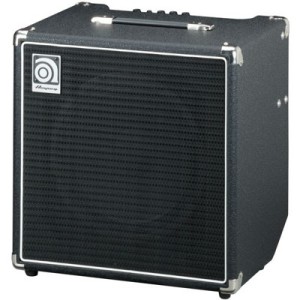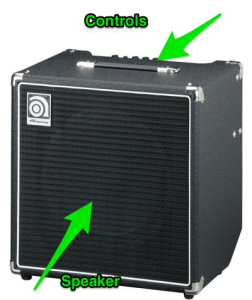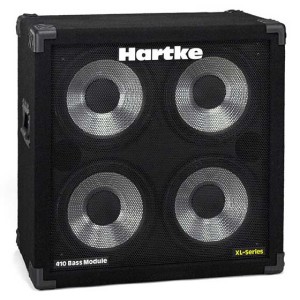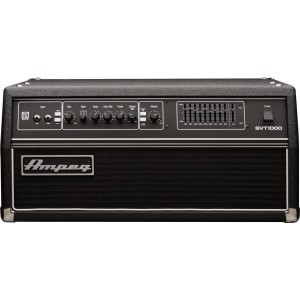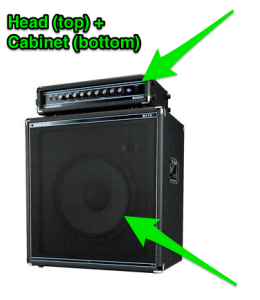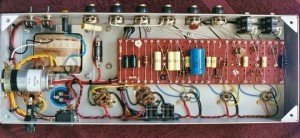Welcome to part 4 of the Bass Essentials Series. In this section, we’re going to look at buying a bass amp particularly:
- Different kinds of amps – solid versus tube and combo versus a cabinet and head
- Speaker sizes
- Some of the key terminology to bear in mind when looking at amps
- and some product recommendations to get you out and playing as soon as possible!
After all, what good is an electric bass without an amp to go along with it?
By the end of this section of the Essentials series, you should have a better understanding of bass guitar amps both in being able to differentiate different kinds of amps from one another as well as to feel confident you can go out and make a purchase that suits your needs as a bass player just starting out.
Bass Amps 101: Some Fundamentals
1. Combo Amp
A combo amp is a type of amplifier where the controls and the speaker are built into one another. If you’re browsing around your local Guitar Center, you’ll probably notice some amps that look like this:
Like I touched on above, the benefit of combo amps is that they are a set of amp controls called the preamp (see below) and a speaker built into one:
Most of the control setting you’ll find on a combo amp are very rudimentary and not meant to tackle any particularly intricate sound shaping. On just about any given combo amp priced between 150 and 500 dollars, you’re likely to get:
- Master volume
- Bass
- Mid (low)
- Mid (high)
- High
- Gain
The master volume controls, well, the entire volume of the amp. The bass knob controls the output of low bass frequencies coming from the amp. The mid knobs – sometimes divided into high and low mids – control their respective sonic frequencies in their own levels of mids and the high knob controls the output of higher frequencies. Finally, the gain control manages how much electrical circuit amplifies the signal.
It’s worth noting that master volume and gain are two seperate things. If you’ve ever turned a gain knob up too high, the sound that comes out is fuzzy, overdriven and at times unpleasant to hear. That’s because there is a tremendous amount of electricity being pumped into that bass signal. Too much gain can blow out your speaker – and that’s bad!
Combos are great for beginners as well as advanced players. Their convienence as well as their sonic output is fantastic for small to mid sized venues and when amplified through a house speaker system can even fill the largest venues with sound. Combos are just as friendly to bedroom musicians as to regularly gigging musicians.
2. Head and Cabinets
Additionally, if you kept walking around Guitar Center, you might encounter things that look like this:
and this:
The top picture is a picture of a cabinet and the bottom is a picture of a head. Together they look like this:
An amp head is essentially the control panel and actually the amplifier of the rig. The cabinet is essentially a large speaker that the sound comes from.
Since amp heads are independent units of the speaker, amp heads have greater capabilities to include more options to shape sounds on their dashboard. A wider range of knobs and EQ controls are typically more common on amp heads than they are on a combo amp.
Amps and heads put together is also called a stack rig.
Now, would a beginner need a full stack rig? Probably not.
Stack rigs are usually meant for regularly gigging bassists playing bigger venues. Not to say that a bassist playing a small time venue wouldn’t benefit from using a stack rather than a combo – but the stack amp might blow the roof off the venue with all that power and sound!
For large halls, auditoriums, and open arenas, high-powered heads matched with a single or double cabinet will be required to get the job done, but again, that is a lot of power and energy usually reserved for more seasoned musicians.
Now, you’re probably wondering: could I use a combo amp with an amp head?
In theory, yes you could – but that’s another article 🙂
Moreover, for someone just starting off on bass, understanding that there are two kinds of amp rigs to consider:
- The combo – which is a speaker and a control panel built in or a
- Stack rig – where two separate components must be purchased: the amp head and the cabinet. Both of which can cost a considerable sum of money.
For a beginner, I’d strongly recommend a combo. Here are some brands and models to consider. Many of these brands are available at your local music store, so getting out to try these shouldn’t be too difficult:
- Acoustic B100MKII 100W Bass Combo Amp
- Gallien Krueger MB 110
- Ampeg BA-110 10 Bass Combo
- Fender Rumble V3 200W 1×15” bass combo
2. Solid State Amplification and Tube Amplification
If you are looking for a high-power bass amp that won’t break the bank, a solid-state amp will probably serve your needs perfectly. Solid state amps are amps that don’t use vacuum tubes in their construction. If you were to go to Guitar Center and plug into any bass amp, it would likely be a solid state.
If you’re looking for a more in-depth explanation of solid state, well, now we’re starting to tread into basic electrical engineering territory.
Wikipedia describes ‘solid-state’ as:
Solid-state electronics are those circuits or devices built entirely from solid materials and in which the electrons, or other charge carriers, are confined entirely within the solid material. The term is often used to contrast with the earlier technologies of vacuum and gas-discharge tube devices and it is also conventional to exclude electro-mechanical devices (relays, switches, hard drives and other devices with moving parts) from the term solid state.
Sounds pretty jargon-y, to me.
For those that are more visually oriented, here’s what a solid state amp’s electronics look like:
What you’ll probably notice is that everything is wired down and soldered in place. No tubes or ‘fragile’ pieces left around.
This is the essence of a solid state amp: pieces and parts are locked into place and sound is produced through charge carriers, not vacuum tubes.
Tube amps (or valve amps) are costlier and tubes are, as you might expect, somewhat more fragile and as a result, usually more expensive to purchase and replace parts for.
Tube combo amps tend to be more common among guitar players. Tube amp products do exist for bass, but usually only as bass amp heads.
To get to the real nitty gritty, the biggest difference between solid state and tube amp is how they react when you turn them up and overdrive them. Solid-state amps will play loud, but once they reach their upper limits, the distortion produced is not particularly musical. Conversely, tube amps will produce a much more mellowed out, controlled sounding overdrive. Have a favorite blues guitar player – that’s likely an example of a ‘pleasantly overdriven’ tube amp.
Bass Guitar Amps for Live, Studio & Practice
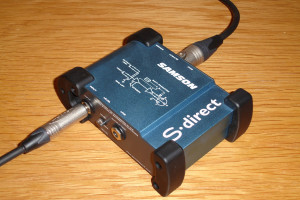 Like we’ve covered above, for the bass player starting out, a small to medium sized combo amp should suffice for introductory gigging just as well as for playing in the bedroom and even recording in the studio.
Like we’ve covered above, for the bass player starting out, a small to medium sized combo amp should suffice for introductory gigging just as well as for playing in the bedroom and even recording in the studio.
But let’s take a moment to talk about recording and live performances. While we’re talking about amps, it’s worth while to make note of what kind of options you have with your amp when recording and playing live.
When you play live, you typically are faced with a choice:
- you can have your amp mic-ed up so that the sound of the amp goes to the microphone and through the house speakers or
- you can have your amp lined out directly into the house speaker system with a Direct Input – or DI – box.
Lining out directly to the speakers give your bass an authentic sound. It’s how your bass actually sounds going through the house system. With a mic, your amp and bass sound sounds more like what the amp is pumping out and how a microphone interprets that sound.
In the studio, the same rationale applies. While it’s considerably easier to line out a bass guitar because all it is is plug and go, it does come with some drawbacks. First, the mix can take a longer time to fit together because of just how ‘real’ the bass sounds. Also, it’s likely not the sound you’re used to hearing from your bass and that can be off putting at first.
With a mic however, setting up the mic correctly so it doesn’t pick up too much or too little bass can be a tricky and time consuming task. But the reward is that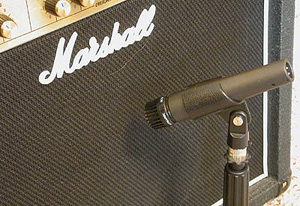 your bass sounds more natural. It sounds like it’s in a room with all the effects that come with being in a room and can produce a much more pleasing recording.
your bass sounds more natural. It sounds like it’s in a room with all the effects that come with being in a room and can produce a much more pleasing recording.
No matter what type of bass amplification you choose, the odds are very good that it will be perfect on the stage or in the studio. Some engineers prefer to run the bass signal through a direct box (DI box), so they can use their existing pro-quality processors to compress or smooth out a bass for recording purposes.
Another option is to use both a DI box as well as a mic on a cabinet, as the combination can produce outstanding bass tracks that sit well in a mix.
Learning about Bass Amps: Key Terms To Bear in Mind
When shopping for amps, there’s going to be a whole bunch of numbers and terms you might find on a bass amp’s spec sheet. Here’s a short guide to help you through those terms:
1. Preamp: A preamp is just what it sounds like – it’s the part of the bass amp that comes before the amplification section. This is the part of the amp that controls the volume and gain of the signal. If your playing on an active bass, the signal naturally is going to be much more active (hotter, as it’s often referred to as) and as a result might have to choose which input to plug into. If given a choice like this, it would be worth considering plugging it into an input that ‘dampens’ the sound – the -15db input (the second one). For passive basses, the 0db input would be best. The entire interfact below is the pre-amp (control panel, knobs, what have you).
2. Tweeter: a kind of speaker cone that reproduces high frequencies. All amps have a tweeter built into them. If you refer back to the pictures of amps above, you’ll notice a black dot in the middle of the speaker cones. That is the tweeter in your amp’s speaker cone.
3. Ohm: Ohm is the measure of the measure of resistance in a circuit to the flow of an electric current. The greater the ohm value the more difficult it is for current to flow through a given circuit. Conversely, a low ohm value represents a low resistance and the easy flow of current through a circuit. Ohms are often used in reference to loudspeakers which have a certain level of resistance associated with them.
A typical speaker may have an ohm rating (rating the speaker’s resistance) of 4 to 8 ohms nominal impedance (impedance being resistance to current flow). Resistance in a speaker varies, however, from low ranges often as low as 2 or 3 ohms to high ranges as high as 30 or more ohms.
Additional Resources:
Looking for more information on bass amps? Check out some of these additional guides:
Musicradar.com has a great video to check out on setting up your amp and walking the user through the various settings on the amp:
Conclusion:
When it comes to buying a bass amp, there certainly are choices and all of these choices and terms can seem pretty daunting.
For a beginner just getting into bass, consider purchasing a small to mid sized combo amp. Combo amps are just as bedroom friendly as they are good for small to medium sized venues like churches, clubs or basements.
The bigger picture is that your amp should, ideally, be:
- functional
- portable and
- serve your needs until you out grow it
With this guide, hopefully the selection process has eased some and you’ll be well on your way to finding the bass amp of your dreams!
- How to Set up a Pedal Board for Bassists - June 16, 2021
- The Best Bass Guitar Effects Pedals Guide You’ll Ever See [INFOGRAPHIC] - April 24, 2020
- The Ultimate Beginner’s Guide to Everything About Bass Guitar Strings - March 20, 2020
